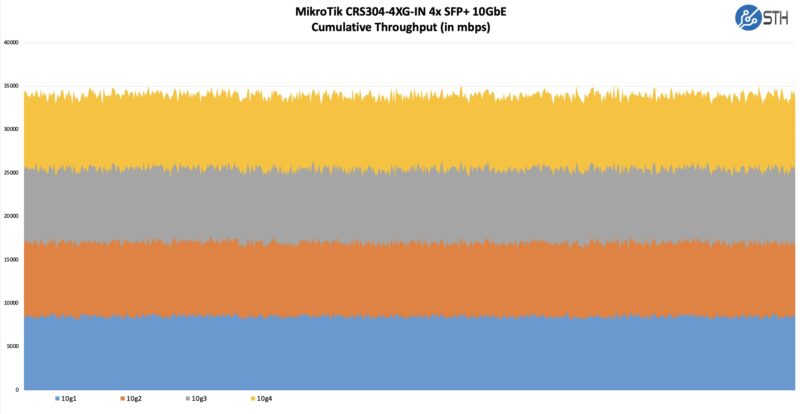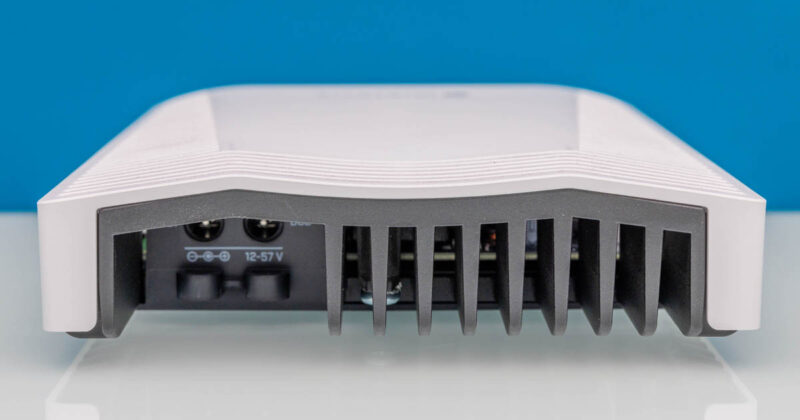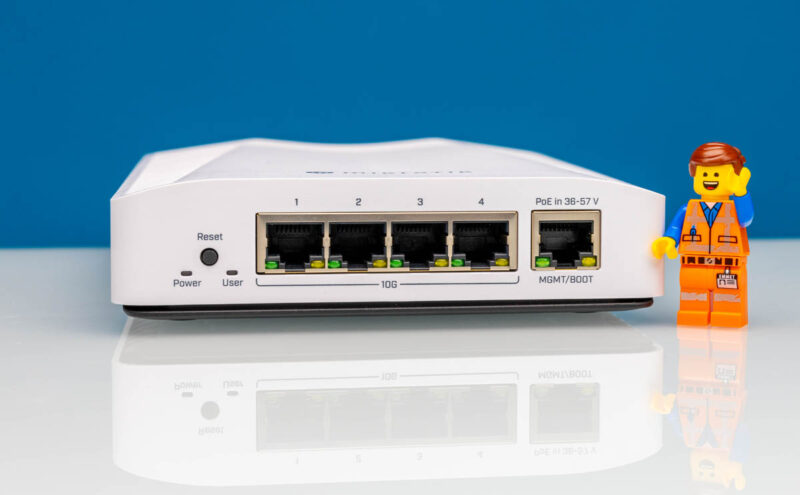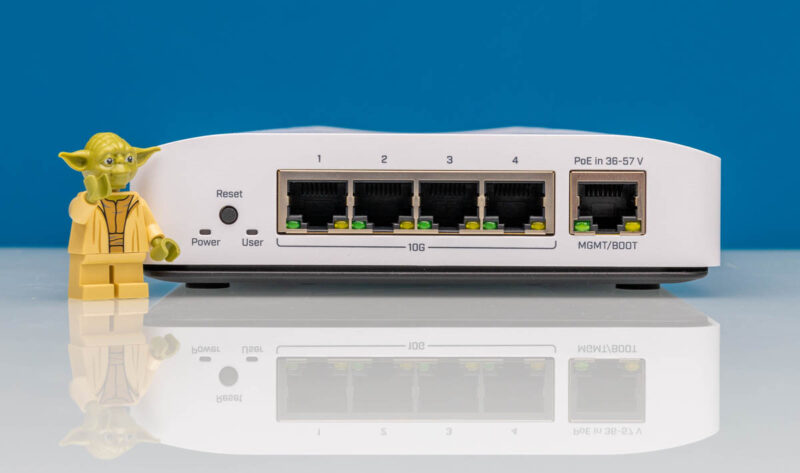MikroTik CRS304-4XG-IN Performance
In terms of performance, we saw what we would expect from a 10Gbase-T switch.

MikroTik has higher-end test gear than us, and they have more detailed results for basic switching. Something notable here is that it appears as though MikroTik did what we did (albeit in full duplex) and used the 4x 10Gbase-T ports, not the additional management port. The Ubiquiti USW-Flex-XG seems to be using the same components and just says 82Gbps of switching capacity. Our sense is that 82Gbps is Layer 1, and Ubiquiti is including the lower speed management port. Assuming they use similar chips, we would expect the Ubiquiti to also be lower at Layer 2 and beyond.

MikroTik has a great CLI, web management interface, and its WinBox management application. On the RouterOS switch, we can see many features. Due to the dual-core Arm design, if one has to go over the CPU for a feature that is not offloaded, expect to be capped at around 2Gbps of throughput.

Perhaps the key lesson here is that this is really a Layer 2 switch with some Layer 3 features that are available, but with a big performance hit.
MikroTik CRS304-4XG-IN Power Consumption
In terms of power consumption, this switch was great. At the wall, one can expect around 7.5-7.8W at idle.

Adding 10Gbase-T ports also added 2-3W per, and there was a sub 1W impact of adding the management port. MikroTik says this switch uses 15W maximum without attachments and 21W maximum. Our sense is that budgeting for perhaps 8-21W is good, albeit usually it is hard to hit a peak. Maybe sharpening the pencil might get you 13-19W as a normal operating range.
Key Lessons Learned
This is THE switch. When MikroTik came out with the MikroTik CRS305-1G-4S+IN, a large portion of STH readers bought one. Having a relatively inexpensive, low-power, and silent switch that could connect multiple SFP+ devices together was just useful. If you were a tech, then having one in the bag to use just to get things running was great. For us, that often meant that those got left in a network as a small SFP+ distribution point. The problem with the CRS305 was that it was SFP+ which is great, unless you need 10Gbase-T.

Instead of turning to SFP+ to 10Gbase-T adapters, one can simply get a 10Gbase-T switch with the CRS304-4XG-IN. At $199 MSRP, we expect that the price will migrate below $170-180 after it is shipping in volume, given MikroTik’s channel discounting behavior. Even at $199, it would cost 50% more to get the Ubiquiti USW-Flex-XG. Unless you are trying to tie into a Ubiquiti management network, the MikroTik CRS304-4XG-IN is the option to get for a 4-port 10Gbase-T switch, and it is not close.
In response to this review, we are likely to have two camps. One will point out that they can get a higher port count, louder, and more power-hungry switch with more offloaded Layer 3 features than this one used on eBay. That is great, but those are different classes of devices. Other folks will likely ask what is the point of a 4-port switch. We showed a quick 10Gbase-T network for a photographer/ videographer with a 10Gbase-T router/ firewall (iKoolCore R2 Max), a workstation PC or Mac, the TerraMaster F8-SSD Plus NAS, and a Blackmagic Cloud Pod to get USB Type-C drives onto a 10Gbase-T network cheaply. That is a great use case for something like this small switch beyond just being a way to patch together a random network. Combine this with a low-cost 10Gbase-T and 2.5GbE switch, and you have a really nice solution for a smaller environment.
Final Words
We have been waiting for a low-cost 10Gbase-T switch for far too long. MikroTik now has something great. This is a clear category leader at $199 or less. It is hard to say that this is a perfect switch since there will be folks who want more ports, more routing performance, and so forth. On the other hand, sometimes it is nice to have something that is low-power and silent.

Perhaps the best thing I can say about this is just to tell you what we are doing around the MikroTik CRS304-4XG-IN. At this point, Patrick and I have used 100+ low-power switches. We both think we will buy more of these little switches, especially given our experience with the CRS305.




The article didn’t mention if this switch could handle MultiGbE speeds or not. Is this a straight 10GbE switch? or an 802.3bz switch?
I will be super excited when true Multi-GbE (100/1/2.5/5/10) switches are available at <$25/port.
This is currently 2x that amount.
Where can we buy this in the USA?
@James
This is similar, but cost $166 USD ($33/port)
5 ports RJ45, managed, 10/5/2.5/1 Gb
https://www.aliexpress.us/item/3256807819991540.html
Regarding the comment above it should be multi-gig. The miss here for me is that the PoE-in port isn’t 10G; having 5x Nbase-T ports with one powering the switch would really make this a killer/must-have device. The closest to this with a non-hamstrung multi-gig PoE-in port (albeit only at 2.5g) is the USW-Flex-2.5G-5.
The mikrotik website says it has 4 multi gig ports.
1G/2.5G/5G/10G
https://mikrotik.com/product/crs304_4xg_in
I’ve been using this switch for a couple of weeks now and it’s been working great. Yes, it does support MultiGbE speeds. One of the computers plugged in to it has an Intel I226-V 2.5 Gig NIC, and it was auto-negotiated and just worked.
I am also using this switch with 4 WisPi USB dongles that get true 5 GbE.
I doubled the speed of my Proxmox cluster for $200 + 4*$30
I agree with James, the price is rather high considering there’s only 4 ports. For just a few extra shekels the CRS309-1G-8S+IN seems to be a better buy.
Minor detail, the article is credited to Patrick, the author is clearly someone else who refers to Patrick several times in the third person.
@Joel:
The thing is CRS309-1G-8S+IN is SFP+ switch. The one who needs 10GBaseT (RJ45) ports that switch is a no-go. Sheer cost of RJ45 SFP+ transcievers (plus extra heat) makes it not so desirable.
Too bad it misses an SFP+ cage ( 4RJ45 + 1SFP+) would have bee awesome ( would have allowed to interconnect easily with the CRS305)
Nice!
@Oarman, it’s probably Rohit. I was thinking the same thing, though.
Thanks for catching that guys. I copy pasted this one into the CMS and forgot to change the credit.
The ports are multi-gig. If you watch the segment on the 2nd set we actually have a 2.5GbE link up for a bit.
Roc-noc.com has stock FS in the USA
As others have said, this is _almost_ the best small switch. An extra SFP+ port would have done it.
For $30 more you can get 5 10GBase-T ports instead of 4. That product is the Trendnet TEG-S750 which is $229 on Amazon. I know some will say the MicroTik option is L3 but no, MircoTik’s firmware is so bad, so obtuse, so totally isolated from the way any L3 firmware works, just say MicroTik is effectively an unmanaged L2 switch. I already have the MicroTik 4 port and 8 port 10G ethernet switches and they are great for cheap L2 10 gigabit. Learning the extremely strange MicroTik way will warp your mind such that you can no longer administer Cisco, Juniper, HPE, Dell, or any other mainstream switch.
@Charles McCane this switch also supports SwitchOS, Mikrotik’s vastly simpler management interface for switches specifically. For some reason they haven’t updated their product page spec sheet but if clicking the PDF brochure or user manual it lists support for it.
@Charles McCane: The reason for that is that Cisco etc. have much more capable and expensive silicon that can do a bunch of things that budget switch chips can’t do. Many manufacturers who use the budget chips opt for unmanaged switches so you get zero extra functionality, but MikroTik take the other option and try to expose as much of the hardware’s functionality as they can. This does mean that things are often done in an obtuse way, but that’s mostly dictated by the hardware implementation of each feature. So you can’t really fault MikroTik for trying to give you access to as much as possible offered by the hardware.
If you prefer a more logical way of doing things, just pay 10 times the price and get a higher end switch with the extra hardware to make it all work, and put up with the extra power draw as well. But for most of us looking at budget low power devices, we appreciate being able to get as much out of our hardware as we can!
I have one of these switches and my expectations for $200 was low.. However, looking at the line rate compared to a switch I have that cost X4 as much with SFP+ at 10Gbe its almost identical. Great value and will be ordering up another. The power draw is also really low at around 15.7 Watts with all 10Gbe plugged in. 10/10 Cool product..
YuanLey 8-Port 10G Ethernet Switch. $250
Includes rack ears.
The knee-jerk reaction was that anything four-port doesn’t rhyme with must-have: it’s been eight-port or trash for me ever since I moved beyond 100Mbit hubs. Especially since my home-lab core has run out of ports, again (currently 28 Nbase-T ports on 3 switches)
But then I noticed that the 2.5 Gbit 8-ports I deploy around the home’s edge, rarely use more than 4 ports. So at price parity 10Gbit wins, even if some cables laid to long ago may refuse the higher bit-rates.
So perhaps that catchy headline isn’t all wrong…
@abufrejoval
Ya it’s tough when you consider that a 4 port switch you’re really only gaining +2 ports from not having a switch at all, since otherwise the uplink would be connected to 1 client directly.
Because of that plus having ports open for future expansion I’m with you on the 8 port minimum.
I have been using this switch for a few weeks as well, and have a couple of questions for anyone with experience with either Microtik or RouterOS:
1. I just want a simple display of the negotiated line rate for each port. The only way I could get this was through the cli.
2. I tried in vain for hours to get this to boot into the simpler swOS, but each time I switched it over, swOS was not accessible, either over the default IP (192.168.88.1) or via DHCP.
Other than these odd issues, it is a completely silent switch that has no problems with multi-gig.
I eventually gave in and got a OWC 10 gBe thunderbolt adapter (used for ~$150).
I am not having a good experience with NFS and the WisdPi’s. I think it can easily be said that the evolving and hacked together Realtek drivers for the 5 GbE (0BDA:8157) usb dongle are not anywhere near as stable the drivers for the 2.5 GbE (0BDA:8156) usb dongle.
So…that 1G “MGMT/BOOT” port. Can it sensibly be used for real network traffic, or do I have to give up one of the 10G ports for the link to my existing gigabit gear?
Also consider the TEG-S750 by trendnet. It is 5x10Gb RJ45 unmanaged fanless switch. I’m not sure if STH has reviewed it, but it’s been working well for me for a year in my home virtualization lab. I use it to handle Veeam Backups to the Repository server.
benny: Yes, five 10G ports instead of four. However, it costs a little more, it’s unmanaged, and it can’t take power over Ethernet.
Couple of items:
The mgmt port can be used like a standard down-stream port for access to the device over LAN (in my case 192.168.0/24)
Device 1 has an IP of 192.168.1.3/24 (gw 192.167.1.1) and is accessible via LAN and can also ping 1.1.1.1 and google.com (DNS functions).
The device seems to magically route and switch traffic without any required VLANs. I have the other 4 ports on a private network segment )192.268.90.0/24) and it just works.
I got a 2nd one of these and was able to easily connect the two devices together via a 10g port. I configured it with an IP address of 192.268.1.13/24, same gw and DNS config.
If I plugged anything into the MGMT port on the 2nd device, all the ports were limited to 1GbE (gigabit). However the device is accessible via LAN and can also ping 1.1.1.1 and google.com (DNS functions).
So I unplugged that port, assuming I would lose access to the 2nd device.
To my pleasant surprise, not only do all 8 ports function at full 10 GbE, I can still access the 2nd device.
It could not route to 192.168.1.1/24 so no way to access internet for upgrades.
As a test I configure another local IP on the 2nd device of 192.168.90.100/24 and somehow the 2nd device can access the net now!
I like to think I know a bit about networking, but I cannot understand how this just works.
Multiple ports with different subnets and no VLANs and still everything is switched properly.
I have to go back to the books and learn more about the difference between L2 switching versus L3 switching.
So now the bit of bad news. I wish I didn’t have to waste hours on trying to get these devices running with swOS, but I got it official word that it is not possible.
—
Hello,
Thank you for contacting MikroTik Support.
Unfortunately, SwOS is not currently available for this device.
Once it becomes available, it will be published on our download page https://mikrotik.com/download, along with changelogs and updates on the forum.
We apologize for any inconvenience this may have caused.
Best regards,
Serhii T.
—
I guess MicroTik is a bit old school.
The devices that support multi-boot (RouterOS and swOS) say so in the specs.
The ones that only support RouterOS simply say they support routerOS.
There is nothing explicit that says it does not support multi-boot (even though the UI lets you try it and waste hours failing to get it to work).
So now the bit of bad news. I wish I didn’t have to waste hours on trying to get these devices running with swOS, but I got it official word that it is not possible.
—
Hello,
Thank you for contacting MikroTik Support.
Unfortunately, SwOS is not currently available for this device.
Once it becomes available, it will be published on our download page https://mikrotik.com/download, along with changelogs and updates on the forum.
We apologize for any inconvenience this may have caused.
Best regards,
Serhii T.
—